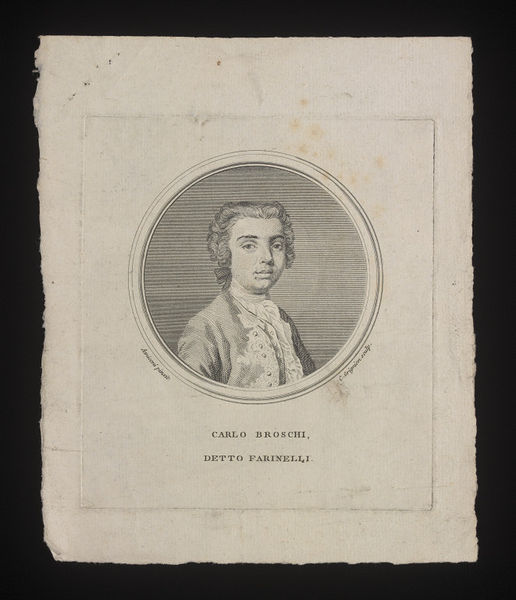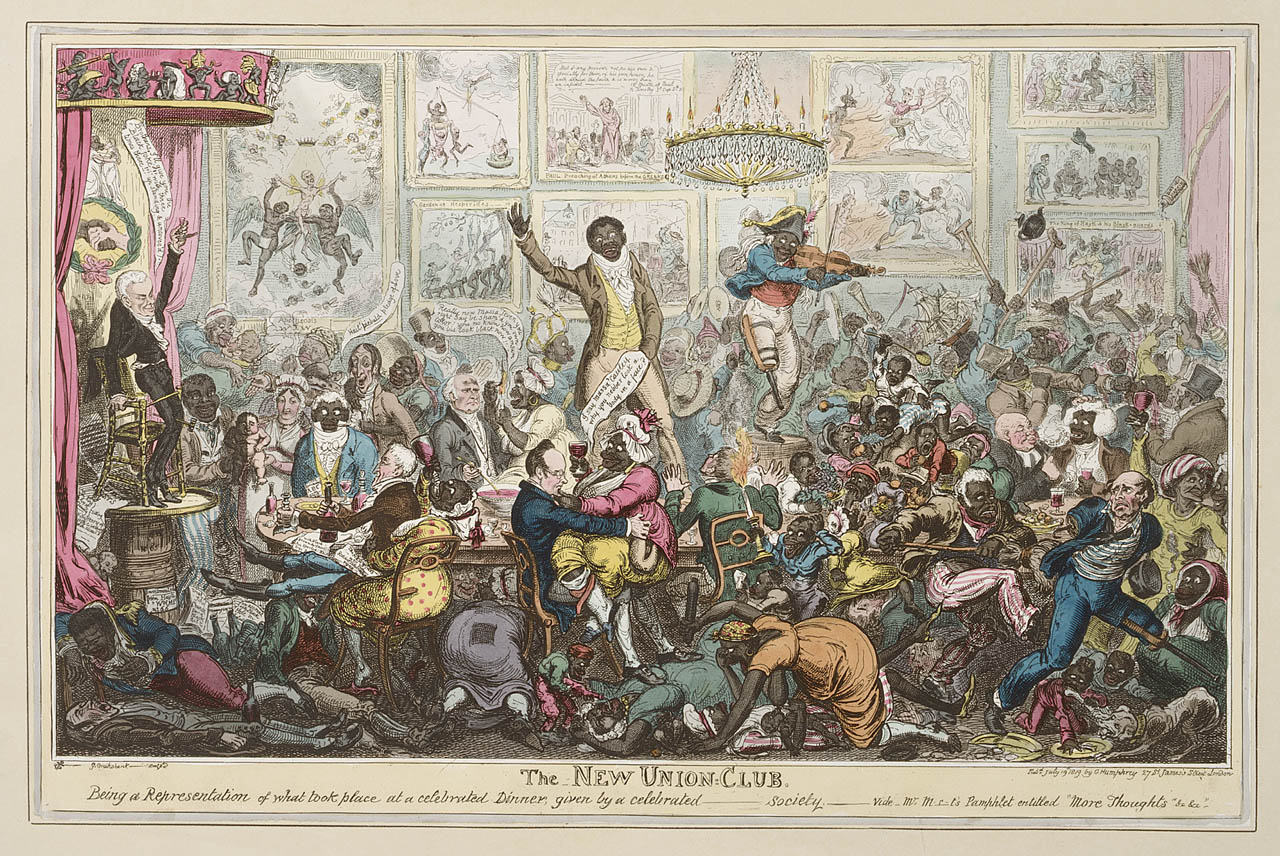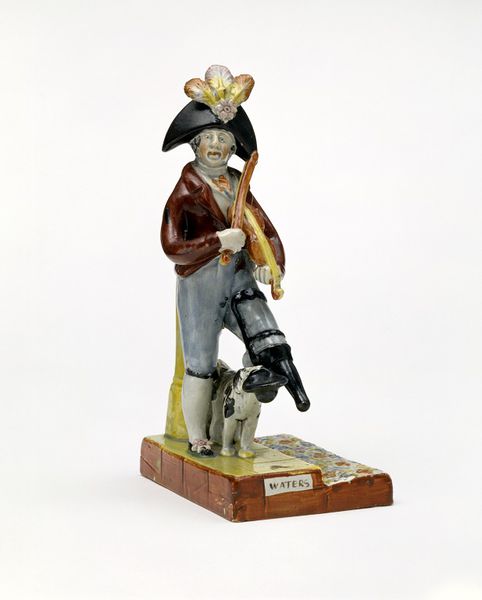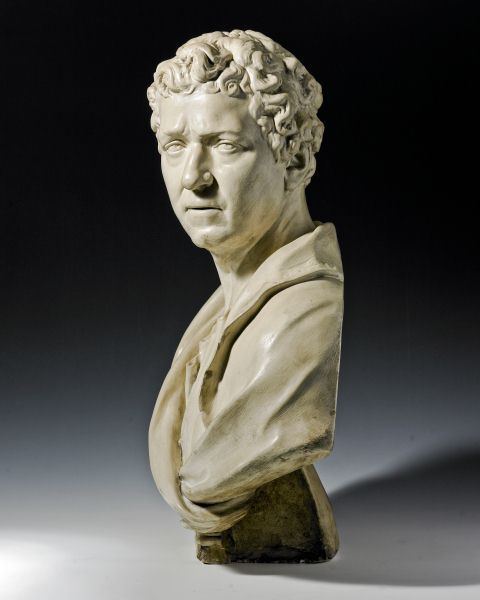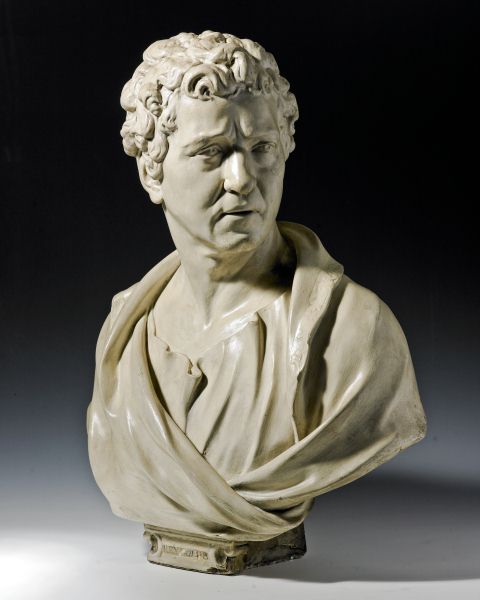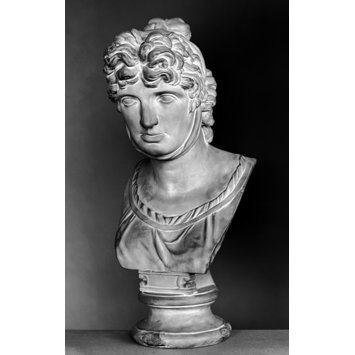Two Mysterious Early 19th Century Plaster Busts
Almost certainly by Shout of Holborn, London.
- certainly not Alexander Pope,
Some notes on the bust of Sir Joshua Reynolds
by Ceracchi.
Some notes and photographs regarding the plaster cast manufacturers Robt. Shout and Peter Sarti.
This Bust has a superficial resemblance to the Roubiliac Busts of Alexander Pope, the drapery on the bust is almost exactly the same as that on the majority of the Roubiliac type busts of Pope but the features are not even close to the Roubiliac busts of Pope.
I have so far discovered two versions of this bust - one in the collection of my great friend and fellow sculpture enthusiast Peter Hone and another at the National Trust house Sudbury Hall, Derbyshire.
Peter Hone has owned this bust for many years see the photographs below.
The two busts have obviously come from the same original? source but the socles are completely different. The socle and eared support on the Sudbury are very similar to that used very frequently by Joseph Nollekens based on an antique precedent., later used by Shout and Sarti.
The Sudbury bust is from one of a group of 5 similar busts at Sudbury Hall (see photographs below).
Some rather poor low resolution photographs from the National Trust website.
NB turned socle and Nollekens type support which appears on the busts depicted below - all at Sudbury, Derbyshire.
______________________________________
Edmund Spenser.
Described on the National Trust website as by (Robert) Shout.
I presume this means that it is inscribed on the back. Given that all five busts share the same detail of the socle and support it follows that it would be safe to assume that these five busts all came from the same manufacturer - most likely Robert Shout.
________________________
Sir Joshua Reynolds.
Plaster.
Sudbury Hall.
Joshua Reynolds.
Plaster Bust.
After Guiseppe Ceracchi.
This must have been cast from Ceracchi’s bust of Reynolds in terracotta, dated 1778, which had been presented to the Royal Academy in 1810.
The terracotta bust had been sold in auction by Greenwood in 1792.
A marble was in the possession of
There is a version by P Sarti at the Atheneum London (see below) -
They say Sarti made new moulds of the bust, but was not allowed to keep them for his own use. "The tunic and cloak were added to the portrait by Sarti, to make the format similar to the others"?
Ceracchi’s terracotta was apparently destroyed (The Age of Neo-Classicism, Council of Europe Exhibition Catalogue, London 1972, no. 335).
The Royal Academy now possesses an undated marble version of the bust, signed Cirachi sculpsit Roma, which was presented by Lord Taunton in 1851. On the cast in the Octagon at the Burlington House (built 1868), the pinned cloak is different from the marble, which suggests that it too had been made from the lost terracotta.
Bust of Sir Joshua Reynolds.
by Giuseppe Ceracchi (1751 -1801).
c.1778 - 9.
Royal Academy
Notes to the busts by the estimable John Kenworthy Brown.
Illustrated on this website are busts of Edmund Burke, David Garrick, William Harvey, Dr Samuel Johnson John Locke, Milton William Murray (Lord Mansfield). Isaac Newton, Sir Walter Scott, and William Shakespeare - all with the same support to the bust but with no socles.
________________________
Plaster Bust of Sir Joshua Reynolds.
Athenaeum Club.
adapted by Pietro Sarti from the original by Ceracchi.
Bust of Sir Joshua Reynolds after Ceracci -
Plaster
Athenaeum Club.
____________________________________
Described on the National Trust website as Classical Man.
......................
Francis Bacon.
After the bust by John Cheere.
There is a version of this bust in bronzes Plaster at York Museums originally supplied to Kirkleatham Hall (see below) by John Cheere in 1749.
See also -
see - http://bathartandarchitecture.blogspot.co.uk/2014/11/the-bronzed-plaster-busts-supplied-by.html
________________________________________
A few notes on Benjamin and Robert Shout.
For a very useful biography of the Shouts by Jacob Simon see -
Robert Shout (described as Mason) insured 12 Eagle Street, Red Lyon Square with the Sun Insurance Company I February 1791
Benjamin and Robert Shout described as Masons and Statuaries are noted as occupying a property behind 13 Eagle Street, Red Lyon Square 31 March 1792 in the records of the Sun Fire Insurance Company (London Metropolitan Archives -
Copy of the list of products available from Robert Shout
c.1801 - 1824.
Trade Card for Benjamin and Robert Shout
Printed sometime prior to the death of Ben. Shout in 1811.
Both cards above from the British Museum Collection.
After the death of Nollekens his assistant Alexander Goblet sold 42 moulds for busts including Jonson and Mansfield to the Plaster Cast manufacturer James Deville (1777 - 1846).
It would appear that Sarti obtained the moulds for some of his busts at some time from the Deville Studio.
The fashion for library busts lasted over two centuries. The busts of various literary, scientific and political characters had a long life. It appears that some of these busts originally cast by John Cheere in the 1740's were then produced by Messrs Harris and Parker in the Strand in the later 18th century. The moulds or masters were then passed to Messrs Shout of Holborn before ending up with Mr Sarti.
__________________________
Group of busts sold at Christie's New York.
sold lot 161, 7 May 2008.
from the Gladstone Collection at Fasque.
Described as A SET OF TWELVE
ENGLISH PAINTED PLASTER BUSTS CAST BY B. & R. SHOUT, FIRST QUARTER 19TH CENTURY.
King Alfred after Rysbrack, John Milton, after original cast by Cheere), William Pitt, Charles James Fox, William Shakespeare ( Poss cast from an original by John Cheere - another at the Wren Library Trinity College Cambridge), Alexander
Pope (after Roubiliac Milton/Fitzwilliam), John Dryden, Alfred the Great, Edmund Burke, Sir Isaac Newton (after Cheere), John
Locke (after Cheere), Samuel Johnson, Milton and Voltaire; each on circular socle topped by a name
tablet.
variously marked 'made by R. Shout/Holborn' and variously dated '1800[?]'
and '1820'
The highest 24 in. (61 cm.) (12)
NB the turned socles and details of the supports
NB also the bust of Pope - this is either a version of the Milton / Fitzwilliam bust of Pope or the later copy by Nollekens. This certainly lends credence to the fact that the Sudbury and Hone busts illustrated above are not poorly sculpted variants of the Roubiliac Pope busts.
______________________________________
Another pair of busts by Shout.
Sold Christies New York lot 162, 7 May 2008.
Catalogue as -
A PAIR OF ENGLISH
PAINTED PLASTER BUSTS OF HOMER AND VIRGIL.
AFTER THE ANTIQUE, CAST BY B. & R. SHOUT, FIRST QUARTER 19TH CENTURY
Each depicted facing frontally on circular socle topped by a name tablet,
Virgil indistinctly marked 'Holborn' to the reverse
22½ in. (57 cm.) high (2).
Again note the detail of socles and supports.
_________________________________
Bust of George Washington after Houdon inscribed Shout, Holborn.
Peter Hone Collection.
Sold at Christies South Kensington.
.......................
Sarah Siddons (1775 - 1831).
Actress.
Plaster bust.
Robert Shout.
Victoria and Albert Museum.
________________________________________
The Peter Hone bust.
with Paper Label from Sandal Hall, Wakefield.
_______________________________
__________________________
Just to avoid any confusion and for comparison with the bust above - below are photographs of the Roubiliac Terracotta and the Marble bust of Pope and the Nollekens Marble bust of Pope now in the Met. The similarity of the drapery on the above bust to the Roubiliac busts should be noted.
This suggests to me that the bust above is taken from another bust from Roubiliac's Studio - Roubiliac sometimes reused the drapery of busts he had created on other busts - the Marble bust of Plato in the Library at Trinity College Dublin by Roubiliac uses this same drapery. See my Trinity College Blog entry. -
Marble bust of Plato.
Workshop of Roubiliac.
Library Trinity College, Dublin.
________________
The Terracotta Bust of Alexander Pope by Roubiliac now in the Barber Institute. Birmingham.
....................................
The Milton Fitzwilliam bust of Pope by Roubiliac.
___________________
The Metropolitan Museum of the Nollekens bust of Pope.
____________________________
Pietro Sarti (1793 - 1868).
For a very useful potted biographies of Pietro (Peter) Sarti (1793 - 1868) and the various members of the Sarti family of plaster cast manufacturers compiled by Jacob Simon of the National Portrait Gallery see
Peter Sarti, resident in London by 1816,
6 Upper King
St, Bloomsbury 1822-1826,
59 Greek St, Soho by 1825-1833, 92 Dean St, Soho
1833-1838,
Southampton St 1836. Plaster cast figure maker and moulder.
___________________________
A few Notes on Sarti and the Athenaeum Club Busts.
_____________
Bill from Sarti to the Athenaeum early 1830
Bought of P.Sarti
|
|
Jany 26th Figure
of Diana Dressing
|
|
|
|
|
Feby 2 Moving
repairing & painting to grecion archer
|
|
|
|
|
|
|
|
|
|
|
|
|
|
|
|
|
|
|
|
|
|
|
|
|
|
|
|
|
Moulding &
casting Sir J. Reynolds
|
|
|
|
|
Putting pedestal
to the Bust of Burke
|
|
Repairing &
painting the Bust of Sir C Wren
|
|
Painting the
Names in the above Busts
|
|
For taken down
& putting twice the Apollo and altering four times the leaf
|
|
|
|
|
All the Articles in
this Bill
are correct. C Daly
£42. 2. 6
Casts Ordered for
payment
Received 30 April
of the Trustees of the
Athenæum the sum of
Forty two pounds two
shillings and
sixpence being the amount of
my Bill for Casts
supplied to the New
Building to this
time – £42. 2. 6 P. Sarti
____________________________
Further busts by
Sarti using the shout type socle and support.
In the Collection of the National Trust, Wimpole Hall,
Cambridgeshire.
The National Trust
owns full-size plaster busts of Locke (white plaster), Milton and Dryden (both
‘bronzed’), and Pope (‘bronzed’, but a different model from that at the Wren
Library). All four have the impressed signature ‘P. Sarti, Dean Street, Soho’. They
may originally have been at Wimpole, but are more likely to have been acquired
as a job lot after 1936 by Captain George and Elsie Bambridge, who owned and
refurnished the house.
Height 62 cms.
................................
Height 71 cms
............................
Height 74 cms.
........................
William Pitt the Younger.
Height 70 cms.
For a very useful essay by Jacob Simon of The National Portrait Gallery see -
____________________________
I am reposting a page from the Charles Harris Catalogue.
which lists the busts available from his shop in the strand in 1777.







